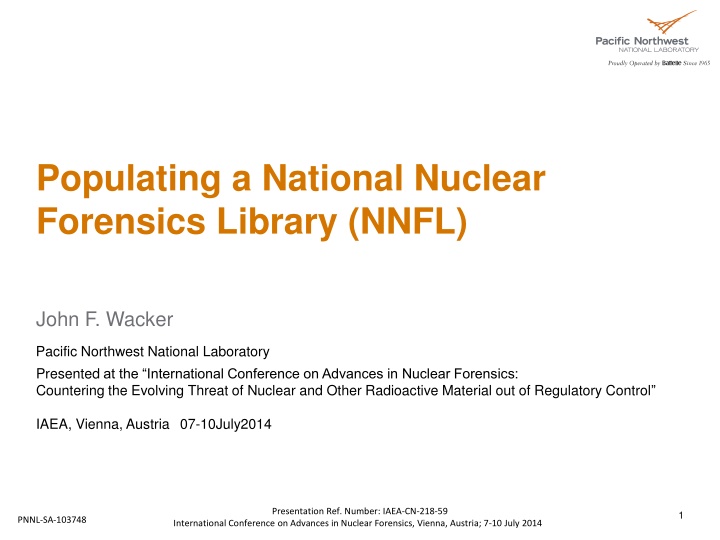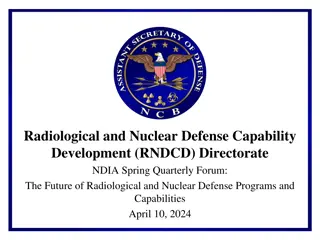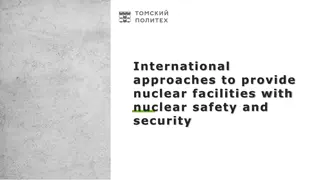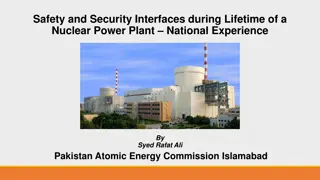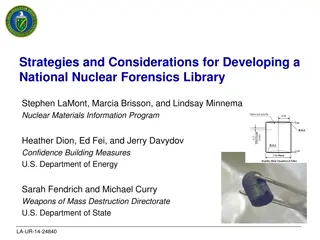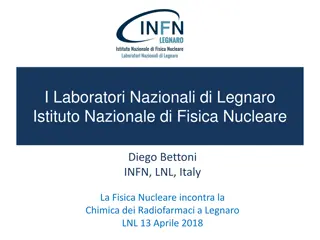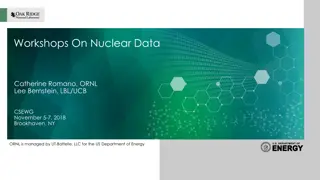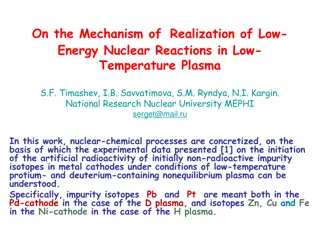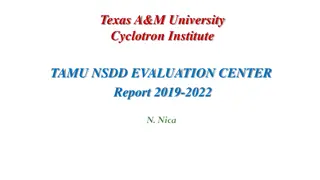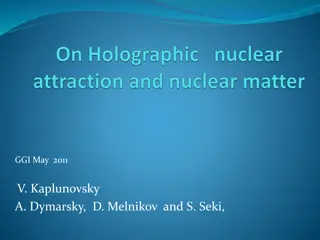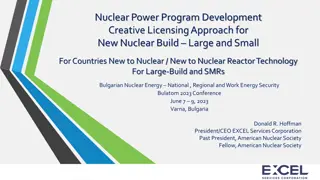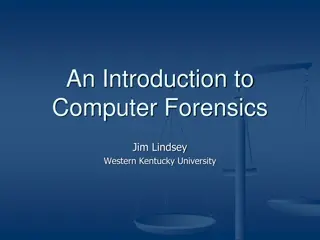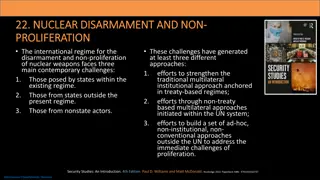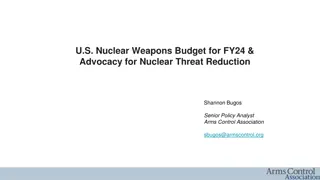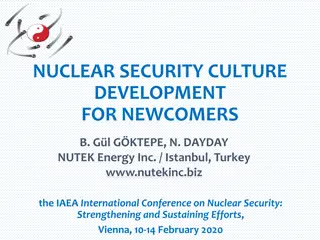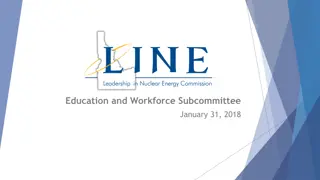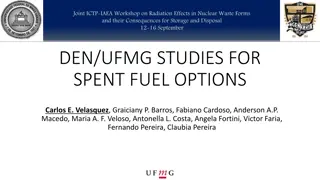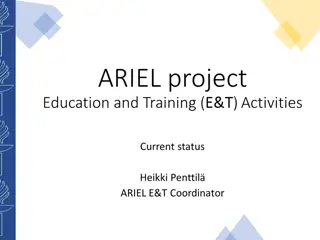National Nuclear Forensics Library Development Overview
The presentation highlights the establishment of the National Nuclear Forensics Library (NNFL) aimed at enhancing nuclear material identification and tracking to counter potential threats. It discusses the approach, goals, and challenges of developing a comprehensive inventory of nuclear materials, emphasizing the importance of data interpretation, comparative analysis, and laboratory processes in ensuring material accountability and security.
Download Presentation

Please find below an Image/Link to download the presentation.
The content on the website is provided AS IS for your information and personal use only. It may not be sold, licensed, or shared on other websites without obtaining consent from the author.If you encounter any issues during the download, it is possible that the publisher has removed the file from their server.
You are allowed to download the files provided on this website for personal or commercial use, subject to the condition that they are used lawfully. All files are the property of their respective owners.
The content on the website is provided AS IS for your information and personal use only. It may not be sold, licensed, or shared on other websites without obtaining consent from the author.
E N D
Presentation Transcript
Populating a National Nuclear Forensics Library (NNFL) John F. Wacker Pacific Northwest National Laboratory Presented at the International Conference on Advances in Nuclear Forensics: Countering the Evolving Threat of Nuclear and Other Radioactive Material out of Regulatory Control IAEA, Vienna, Austria 07-10July2014 Presentation Ref. Number: IAEA-CN-218-59 1 PNNL-SA-103748 International Conference on Advances in Nuclear Forensics, Vienna, Austria; 7-10 July 2014
Acknowledgements Pacific Northwest National Laboratory Andy Luksic (retired) US Department of Energy Marcia Brisson (Nuclear Materials Information Program (NMIP)) Stephen LaMont (Nuclear Materials Information Program (NMIP)) Heather Dion (National Nuclear Security Administration) US Department of Homeland Security William Ulicny Los Alamos National Laboratory David Olivas Joe Watts Savannah River National Laboratory Donna Beals (retired) 2 PNNL-SA-103748
United States NNFL Goal: Ensure domestic material would be recognized if interdicted or used in a terrorist event Approach: Develop a Library and necessary support structure National Nuclear Forensics Library Entire U.S. effort is part of the U.S. Nuclear Materials Information Program (NMIP) Data Interpretation and Comparative Analysis Laboratory Analysis and Process Modeling National Nuclear Material Archive 3 PNNL-SA-103748
U.S. NNFL: Implementation Data Dictionary: Published Database: Under Development National Nuclear Forensics Library Data DOE Laboratories Interpretation and Comparative Analysis Los Alamos Y-12 Laboratory Analysis and Process Modeling National Nuclear Material Archive 4 PNNL-SA-103748
Developing an Inventory If some nuclear material is found outside of administrative controls anywhere in the world, can each country answer the question: Is it ours? Verifying inventory may confirm that material does not appear to be missing, but that may not be sufficient 5 PNNL-SA-103748
Developing an Inventory Fully characterizing the US inventory of nuclear materials is a challenging and complex task The US has been producing nuclear materials for ~70 years The US inventory includes a wide variety of uranium and plutonium Physically Chemically Isotopically Any of these can be modified, though changing the isotopics is the most difficult 6 PNNL-SA-103748
Searching for Nuclear Materials Data Nuclear Materials Management & Safeguards System (NMMSS) U.S. government s information system containing current and historic data on the possession, use, and shipment of nuclear materials. NMMSS contains some materials information, but does not contain sufficient details needed for nuclear forensics analysis Production facilities Information is available on various materials, produced and recycled But, the data are often incomplete, e.g., data showing that specifications have been met Thus, NMIP needed to develop a more detailed database of materials characteristics Nevertheless, information in NMMSS and other databases has proven to be valuable and is being utilized by NMIP 7 PNNL-SA-103748
Finding the Data NMMSS Weapons Program Material Production Weapons Production Surveillance Disposition Fuel Fabrication Publications/Reports National Laboratories Scientific Journals 8 PNNL-SA-103748
Mining Existing Data Isotopic Composition (NMMSS) Uranium weight and U-235 content Plutonium weight and Pu-239 content Initial characterization (but we require more!) Uranium: U-232, U-233, U-234, U-236 Plutonium: Pu-238, Pu-240, Pu-241, Pu-242 Other sources have additional data, but is it useful? 9 PNNL-SA-103748
Effect of Process Histories Different processes impart different signatures. Identifying signatures associated with processes we used, potentially allows us to include or exclude unknown material as being ours. We need to identify those signatures and acquire the associated data on our material. 10 PNNL-SA-103748
Data Goal: Full Characterization of Nuclear Materials Relevant material characteristics includes: Isotopic composition Elemental composition Chemical form Physical form Processing age Morphology This presentation will discuss the U.S. experience 11 PNNL-SA-103748
Data Detailed information on isotopic compositions is our initial priority Pu-238 Pu-239 Pu-240 Pu-241 Pu-242 U-233 U-234 U-235 U-236 U-238 First, acquire available information Identify Gaps, and work to fill them 12 PNNL-SA-103748
Data NMMSS provides high-level characterization for most attributes Types of historic data sets Facility Production Records Shipments from Production Site Rocky Flats measurements Integrated Surveillance Program (MOX program) R&D Measurements Much of the U.S. data is hard copy Much is no longer available 13 PNNL-SA-103748
Data Tens of thousands of records Numerous facilities Varying requirements Quality determined by requirements Accuracy may be goal of measurement Within specification may be sufficient Less than may be good enough Function of time (we got better as time progressed) Measurements performed for production purposes are generally not sufficient for forensic purposes 14 PNNL-SA-103748
Measurements 15 Characterization of plutonium changed significantly over time 1940s-1950s neutrons/g-sec mid-1950s Pu-240 late-1960s Pu-240, Pu-241 mid-1970s Pu-240, Pu-241, Pu-242 1980s Pu-240, Pu-241, Pu-242, Pu-238 Uranium data evolved to include U-236, U-234 and other minors Recorded data changed with time Recorded data changed with utilization 15 PNNL-SA-103748
Measurements DA vs. NDA 0.0005 0.0004 NDA Pu242/Pu239 0.0003 0.0002 0.0001 DA 0.0000 0.00 0.02 0.04 0.06 0.08 0.10 Pu240/Pu239 16 PNNL-SA-103748 16
Measurements CANDU NRX PWR BN-600 (UO2) Hanford 327 C Hanford 727 C 1.0E-03 NDA 1.0E-04 Pu-242/Pu-239 DA 1.0E-05 1.0E-06 0.00 0.01 0.02 0.03 0.04 0.05 0.06 0.07 0.08 0.09 0.10 17 Pu-240/Pu-239 PNNL-SA-103748
Data Vetting: Verification and Validation 1 DATA for SUBMISSION to NNFL 2 DATA INPUT Manual Entry or Electronic Data from another Database 3 REVIEW INPUT DATA 4 5 DATA VERIFICATION By Database Expert DATA VALIDATION By Subject Matter Expert 6 AUTHORIZE By SME and Database Expert & Release Data To NNFL 18 PNNL-SA-103748
Issues for Data Vetting Transcription errors Typos, improperly transferred characters, etc. Field mismatches Truncating number strings, conversion amongst different numeric formats (for instance from integer to scientific notation) Text to numeric conversions e.g., parsing text information into numeric or alphanumeric fields Less-than values, detection limits, non-reported data e.g., <500 ppm or not detected What should be entered when a numerical value is expected by the database? Values with no quoted uncertainty Very common in older database Unit conversions or mismatched units 19 PNNL-SA-103748
Gaps and Prioritization 20 Acquiring data is a work in progress Largest inventory categories first Isotopics is considered the primary characteristic Other data (elemental composition, trace elements, etc.) to be obtained as available Conclusions to date All historic data is not be available All historic data is not suitable for forensic applications Different analytical techniques produce different results Modeled data may be required in the interim New measurements will be required Planning and Prioritization is in progress 20 PNNL-SA-103748
